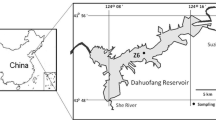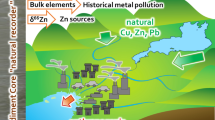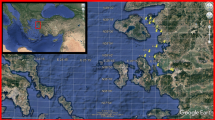Abstract
The Rio Grande Reservoir supplies water to four counties. Two sediment cores were collected, one was sliced every 2 cm for INAA and dating determinations; the other was cut every 5 cm, for grain size and Hg, Cd, Pb, Ni, Mn and Cu determinations. Sedimentation rates and sediment ages of every layer were determined by 210Pb method. Enrichment Factor (EF) and Geoaccumulation Index (I geo) were calculated. Significant enrichment was found for Na, Mn, Ni, Pb, Sb and Zn and extremely high enrichment for Hg, Cu and Cd, in upper layers. A 90 year pollution history of this reservoir was traced.




Similar content being viewed by others
References
CETESB (2011) Qualidade das águas superficiais no estado de São Paulo––(2010)—Apêndice B. CETESB, São Paulo
Cánovas CR, Olias M, Vasquez-Suné E, Ayora C, Nieto JM (2012) Sci Tot Environ 416:418–428
Silvério PF (2003) Bases técnico-científicas para derivação de valores guia de qualidade de sedimentos para metais: experimentos de campo e laboratório. PhD Thesis, Escola de Engenharia de São Carlos-USP, p 145
Quináglia GA (2012) Caracterização dos Níveis basais de Concentração de metais nos sedimentos do sistema estuarino da Baixada Santista. Biblioteca 24 horas, São Paulo
Gomes FC, Godoy JM, Godoy MLDP, Carvalho ZL, Lopes RT, Sanchez-Cabeza JAS, Lacerda LD, Wasserman JL (2009) Mar Poll Bull 59:123–133
Audry S, Schaefer J, Blanc G, Jousnneau J-M (2004) Environ Pollut 132(3):413–426
Albarede F (2011) Geoquímica. Uma Introdução. Oficina de Textos, São Paulo
Franklin RL, Ferreira FJ, Bevilacqua JE, Fávaro DIT (2012) J Radioanal Nucl Chem 291(1):147–153
Luiz-Silva W, Machado W, Matos RHR (2008) J Braz Chem Soc 19(8):1490–1500
Sutherland RA (2000) Environ Geol 39(6):611–627
Fávaro DIT, Damatto SR, Moreira EG, Mazzilli BP, Campagnoli F (2007) J Radioanal Nucl Chem 273(2):451–463
Bostelman E, (2006) Avaliação da concentração de metais em amostras de sedimento do reservatório Billings, braço Rio Grande, São Paulo, Brasil. MSc Thesis, IPEN-USP, p 117
Moreira EG, Vasconcellos MBA, Saiki M (2006) J Radioanal Nucl Chem 269(2):377–382
Larizatti FE, Fávaro DIT, Moreira SRD, Mazzilli BP, Piovano EL (2001) J Radioanal Nucl Chem 249(1):263–268
Damatto SR (2009) In: Proceedings of international tropical conference on Po and radioactive Pb isotopes, Sevilla, España
Leonardo L, Damatto SR, Gios BR, Mazzilli BP (2014) J Radioanal Nucl Chem 299(3):1935–1941
http://www.epa.gov/epawaste/hazard/testmethods/sw846/pdfs/3051a.pdf. Accessed 23 Jan 2012
Norma técnica L6.160 (1995) Sedimentos: determinação da distribuição granulométrica-método de ensaio. CETESB, São Paulo
Loska K, Cebula J, Pelczar J, Wiechula D (1997) Kwapuliski. Water Air Soil Poll 93:347–365
Loska K, Wiechula D, Barska B, Cebula E, Chojnecka A (2003) Poll J Environ Stud 12(2):187–193
Loska K, Wiechula D, Korus I (2004) Environ Inter 30:159–163
Szefer P, Skwarzec B (1988) Mar Chem 23:109–129
Dias MI, Prudencio MI (2008) Microchem J 88:136–141
Hernandez L, Probst A, Probst JL, Ulrich E (2003) Sci Tot Environ 312:195–219
Lin C, He M, Zhou Y, Guo W, Yang Z (2008) Environ Monit Assess 137:329–342
Zhang J, Liu CL (2002) Est Coast Shelf Sci 54:1051–1070
Wedepohl KH (1995) Geochim Cosmochim Act 59(7):1217–1232
Bode P (1996) Instrumental and organizational aspects of a neutron activation analysis laboratory. Interfaculty Reactor Institut, Delft
Franklin RL, Bevilacqua JE, Fávaro DIT (2012) Quím Nova 35(1):45–50
Author information
Authors and Affiliations
Corresponding author
Rights and permissions
About this article
Cite this article
Franklin, R.L., Fávaro, D.I.T. & Damatto, S.R. Trace metal and rare earth elements in a sediment profile from the Rio Grande Reservoir, São Paulo, Brazil: determination of anthropogenic contamination, dating, and sedimentation rates. J Radioanal Nucl Chem 307, 99–110 (2016). https://doi.org/10.1007/s10967-015-4107-4
Received:
Published:
Issue Date:
DOI: https://doi.org/10.1007/s10967-015-4107-4




